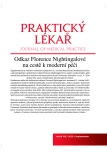Quality of Life of Patients after Polytrauma in Relation to the Injury Severity Score
Authors:
P. Segarová 1,2,3; J. Slaný 3; L. Pleva 1,2; L. Pavliska 1
Authors‘ workplace:
Klinika úrazové chirurgie Fakultní nemocnice Ostrava
1; Ústav medicíny katastrof Lékařské fakulty Ostravské univerzity v Ostravě
2; Fakulta zdravotnictví a sociální práce, Trnavská univerzita v Trnave, Slovensko
3
Published in:
Prakt. Lék. 2020; 100(Supplementum): 38-43
Category:
Overview
Introduction: The aim of the presented work was to measure the quality of life of patients after polytrauma, which is associated with significant permanent consequences for the patient. Introduction of new treatment techniques results in a high percentage of these patients surviving this type of injury. Permanent consequences may cause problems for the injured, especially in social interaction with their environment.
Aim: To determine the subjective of quality of life and to determine whether the quality of life is associated with the ISS score (Injury Severity Score), whether the subjective quality of life and satisfaction with medical condition are associated in any way with the period of time which has elapsed from the serious injury, and what are the prerequisites for successful reintegration of these patients onto the labour market.
Method: The authors performed a literature review using the PubMed online database, hospital information system, and statistical evaluation of questionnaires from the responders. The group of responders consisted of patients treated at our department. In order to perform the measurements, the authors used the WHOQOL-BREF (WHO, 2008) questionnaire, and compared the obtained results with the population standard of subjective quality of life reported by Dragomirecká et al. (2006).
Results: A total of 49 questionnaires were statistically evaluated; the responders evaluated their quality of life to be higher than the interval of population standard in three domains. The domain of Social Relations was evaluated as very bad in all responders. Also the responses to questions concerning the quality of life and satisfaction with medical condition were below the average value of the population standard. The quality of life was not related to the ISS score of the trauma in any way. The period, which has elapsed from the injury, influences the subjective quality of life of the individual, and the satisfaction with medical condition.
Conclusion:The subjective quality of life of patients after polytrauma certainly is in the foreground of attention of social work, especially due to the permanent consequences, limiting the patient’s abilities to find application at the labour market. The broad distribution of data in our dataset and various measurement techniques presented in the literature lead the authors to the conclusion that more conclusive means of measurement will include qualitative techniques, working together with the patient, ever since the injury, over the treatment period, physiotherapy, up to social reintegration.
Keywords:
polytrauma – Injury Severity Score – subjective quality of life.
Sources
- Baranyi A, Leithgöb O, Kreiner, B, Tanzer K, Ehrlich G, et al. (2010). Relationship Between Posttraumatic Stress Disorder, Quality of Life, Social Suport, and Affective and Dissociative Status in Severely Injured Accident Victims 12 Months After Trauma. Psychosomatics. 2010; 53 (3): 237–247.
- Dragomirecká E, Bartoňová J. (2006). WHOQOL-BREF, WHOQOL-100. Praha: Psychiatrické centrum 2006; 23–45.
- Gnass, Ritschel, Andrich, Kuske, Moschinski (ed.). (2017). Assessment of patient – reported outcomes after polytrauma: protocol for a systematic rewiew. /cit. 2018-05-10/ Prospero. Available from: https://www.crd.york.ac.uk/prospero/display_record.php?ID=CRD42017060825.
- Gurková E. (2011). Hodnocení kvality života pro klinickou praxi a ošetřovatelský výzkum. Praha: Grada Publishing., a.s. 2011.
- Lefering L, Tecic C, Schmidt Y, Pirente N, Bouillon B, et al. (2012). Quality of life multiple trauma: validation and population norm of Polytrauma Outcome (POLO) cart. Eur J Trauma Emerg Surg. 2012; 4 (38): 403–415.
- Pleva L. (2016). Polytrauma. In: Doleček R. a kol. Endokrinologie traumatu. Maxdorf: Praha; 137–151. ISBN: 978-80-7345-484-5.
- Pleva L, Zeman M. (2014). Polytrauma. In: Zeman M, Krška Z, a kol. Speciální chirurgie. Praha: Galén 2014; 431–435.
- Polinder S, Haagsma JA, Belt E, Lyons RA, Erasmus V, et al. (2010). A systematic rewiev of studies measuring health-related quality of life of general injury populations. BMC Public Health. 2010; 10 (783): 1–22.
- R. Core Team R. (2018). A Language and Environment for Statistical Compuning. Vienna. [on line] [cit 25. 11. 2018]. Available at: https://www.R-project.org.
- Šrámková T. (2013). Poruchy sexuality u somaticky nemocných a jejich léčba. Praha: Grada Publishing, a. s. 2013.
- Tomeš I. (2010). Úvod do teorie a metodologie sociální politiky. Praha: Portál 2010.
- ÚZIS ČR.(2019). Národní registr úrazů. Kompletní metodika sběru dat. Verze 080_20190101. 1-78. [on line] [cit 31. 1. 2016]. Dostupné z WWW https://www.uzis.cz/zavazne-pokyny/narodni-registr-urazu-kompletni-metodika-sberu-dat
- Věstník MZ ČR. (2015). Centra vysoce specializované traumatologické péče a Centra vysoce specializované péče o pacienty s popáleninami. 2015; 15 : 2–20.
- WHO. (1997). WHOQoL Measuring quality of life [on line] [cit 31. 1. 2016]. Dostupné z WWW http://www.who.int/mental_health/media/en/68.pdf.
- WHO.(2008). Mezinárodní klasifikace funkčních schopností, disability a zdraví. Grada: Praha 2008.
- XIE Y.(2016). A General-Purpose Package for Dynamic Report Generation. [on line] [cit 31. 1. 2016]. Available at: https://CRAN.R-project.org/package=knitr.
Labels
General practitioner for children and adolescents General practitioner for adultsArticle was published in
General Practitioner

Most read in this issue
- Factors Influencing Job Satisfaction and Motivation of General Nurses
- Coping of students in study programs General nursing and Paramedic
- Nurses‘ Role in Prescribing Medication
- Clinical simulation as a method in midwifery teaching
